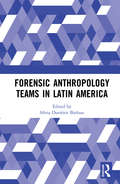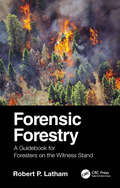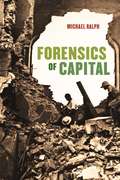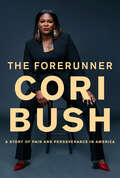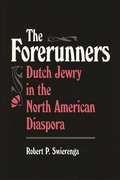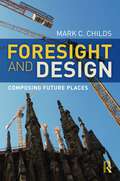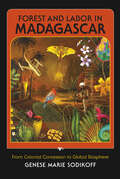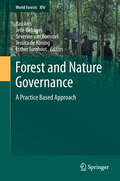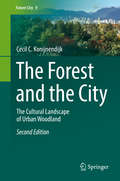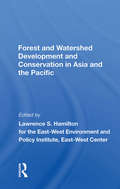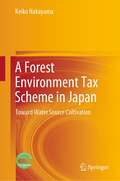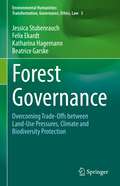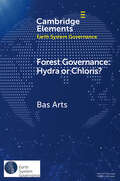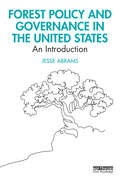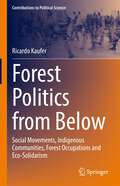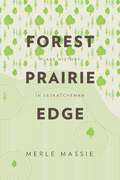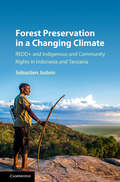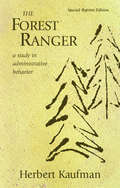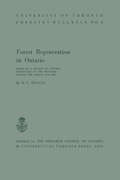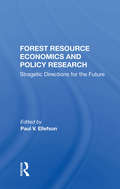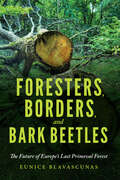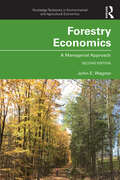- Table View
- List View
Foreldreløse-sammensvergelsene
by James Morcan Lance Morcan Elisabet NorrisDenne saksprosa boka handler om politiske, vitenskapelige og finansielle innsikt inn i Morcans' bestselgende internasjonale trillerserie Den Foreldreløsetrilogien (noveller som slår sammen fakta og fiksjon ved å innarbeide virkelige teorier om offentlige personer og store organisasjoner). Her gir forfatterne detaljert analyse for hver enkelt av disse kontroversielle teoriene. Foreldreløse-sammensvergelsene, med forord fra den ledende forskeren Dr. Takaaki Musha og etterord av den berømte historikeren Professor Richard Spence, innbefatter vanskelig-å-finne kunnskap. På mange måter er dette grundig undersøkte verket den hemmelige historien om 20. og 21. århundre. Men mer enn bare en historie, avslører den også hva som skjer akkurat nå bak kulissene - i undergrunnsbunkere, i maktens korridorer, i de største bankene og møtene hos verdens eliter. Morcanene kobler prikkene mellom mange illberyktede hendelser i nyere tid og fjerner de tilsynelatende uendelige klassifiserte lagene av regjeringer og etterretningsbyråer. Sjokkerende, avslører de en avbryter sivilasjon som arbeider i blant oss og har til rådighet ekstraordinære undertrykte teknologier, ubegrensa ressurser og enorme svarte budsjetter - alt uforvarende finansiert av hverdagens skattebetaler. Med sine innsamlede bevis fra rettsaker, deklassifiserte regjeringsfiler og hovedstrømmens medierapporter, formidler forfatterne lite kjente fakta om en lang rekke emner. Skrevet fra forskjellige perspektiver; enkelte ganger ved å gi en stemme til sammensvergelsesteoretikere; andre ganger ved å støtte tvilere; skiftende mellom seriøs undersøkende skriving og ironi, selvironisk humor - leverer Foreldreløse-sammensvergelsene en balansert avsløring av noen av de viktigste saker i vår tid. Gå lengre enn rykter og sammensvergelsesteorier til dokumenterte fakta og bekreftet virkelighet og finn ut hvor dypt kaninh
Forensic Anthropology Teams in Latin America
by Silvia Dutrénit BielousThis book charts the development of forensic anthropology teams in Latin America and surveys their main characteristics, achievements, and challenges in light of a recent past fraught with state repression and violence. The volume contains contributions by an interdisciplinary group of scholars from several Latin American universities, with chapters on Argentina, Chile, Uruguay, Peru, Guatemala, and Mexico. These countries’ shared legacy is a host of human rights violations that continue to have an impact on present day society. Following the move towards democracy and a public demand for truth and justice, the volume highlights the role of forensic anthropology teams and their contribution as a source of information for the historical narrative, as a legal asset in enforcing the right to truth, and in achieving reparation for victims. This collection will be of interest to scholars from Anthropology, Latin American Studies, Politics, and History.
Forensic DNA Transfer
by Jane Moira TaupinForensic DNA Transfer provides a guide to the recognition and current understanding of DNA transfer in forensic criminal investigations. Increased improvements in technology mean that it is now routinely possible to obtain DNA profiles from non-visible deposits. How or when the DNA in question was deposited may be an issue in the context of the case, especially if the donor of the DNA is not in dispute. A DNA profile alone cannot reveal when or how that DNA was deposited at a crime scene, nor can it reveal the body matter from which it originated. Issues of transfer associated with activities may be debated – which the traditional discrimination purpose of DNA profiling cannot address. DNA may be everywhere and anywhere – in homes, at workplaces, during transport, and on personal items including clothing. DNA from a person may be on an object they have never contacted or in a room they have never entered. Concepts discussed in the book include non-self DNA on hands through day-to-day activities, the prevalence of background DNA in the environment and perhaps on the exhibit, the persistence of any DNA transferred, and that a DNA result will depend on these variables as well as recovery techniques. Since DNA may be transferred to an exhibit: (a) during the commission of a crime, (b) before the crime, and/or (c) after the crime through handling, examination, and testing, this book covers various transfer pathways and sources of DNA. Inadvertent issues of transfer of DNA resulting in wrongful convictions and the misleading of investigations are discussed, with an emphasis on contamination mitigation. Forensic DNA Transfer examines the additional complexity resulting from non-visible deposits of DNA that impact on sampling and testing regimes. The changing understanding of the composition of purported 'touch DNA' deposits from the skin, including extracellular DNA transported via body secretions is described. Further, the newer focus on interpreting DNA evidence – using activity level propositions and the rationale and associated issues – is also discussed.
Forensic Forestry: A Guidebook for Foresters on the Witness Stand
by Robert P. LathamForensic Forestry: A Guidebook for Foresters on the Witness Stand is a one-of-a-kind, hands-on resource for those forestry and land use professionals called upon to work on legal cases and testify in court. Land use and forestry issues in the United States, in particular—and likewise around the world—have become increasingly contentious, scrutinized, and debated. There is little to suggest that conflicts over forestlands will cease in the near future, in fact, quite the opposite. There are already a number of informative books available on land use and forestry, and related issues under the broader heading of environmental science. As such, while this book will not go into these concepts in detail, if someone is already an expert in land use and forestry, this book will tell them the ins and outs of the legal system and how they can best serve to make a case, using evidence, in a court of law. Coverage addresses the necessary background, and legwork involved, in providing technical expertise for such cases to be adjudicated. Since professionals’ expertise is often focused on ecological issues, chapters look at the economic factors and how money, policy, and corporate interests come into play—the crux of where the professional forester’s ability to present evidence and expertise becomes critical. The author provides an overall understanding of the courts, and the legal process. Coverage includes recommendations to professionals working on cases—and in the courtroom—in how to present evidence and testify in cases over land use and forestland rights, forestry management and safety, criminal and civil cases in liability in forest fires—among myriad others. Key Features: A book by a professional for professionals in the field of forestry and those called to testify in cases of forest and wildfires, eminent domain, land disputes, tort, and liability cases Written in easy-to-read, non-technical jargon to provide tools to best serve as an expert witness and consultant to support attorneys in civil and criminal cases Details unique, real-world cases study examples, detailing how they were adjudicated based on evidence and testimony provided Presents a legal background into the court system, courtroom procedure, the types of legal cases as they relate to forensic forestry As such, Forensic Forestry is a welcome addition to those professionals called upon to consult on, and testify in, such cases including land use professionals, foresters and forestry managers, ecologists, environmentalists, environmental policy advocates, and those in related fields.
Forensic Social Work: Psychosocial And Legal Issues Across Diverse Populations And Settings
by Tina Maschi George Stuart LeibowitzThis extensively revised edition reviews the latest research and practices in forensic social work. Readers learn to integrate socio-legal knowledge when working with diverse populations in a variety of settings. Noted interdisciplinary contributors review the most common forensic issues encountered in the field to better prepare readers to deal with the resulting financial, psychological, emotional, and legal ramifications. Using a human rights and social justice approach, the book demonstrates the use of a forensic lens when working with individuals, families, organizations, and communities that struggle with social justice issues. Each chapter features objectives, competencies, Voices From the Field, a conclusion, exercises, and additional resources.
Forensics of Capital
by Michael RalphAs one of Africa’s few democracies, Senegal has long been thought of as a leader of moral, political, and economic development on the continent. We tend to assume that any such nation has achieved favorable international standing due to its own merits. In Forensics of Capital, Michael Ralph upends this kind of conventional thinking, showing how Senegal’s diplomatic standing was strategically forged in the colonial and postcolonial eras at key periods of its history and is today entirely contingent on the consensus of wealthy and influential nations and international lending agencies. Ralph examines Senegal’s crucial and pragmatic decisions related to its development and how they garnered international favor, decisions such as its opposition to Soviet involvement in African liberation--despite itself being a socialist state--or its support for the US-led war on terror--despite its population being predominately Muslim. He shows how such actions have given Senegal an inflated political and economic position and status as a highly credit-worthy nation even as its domestic economy has faltered. Exploring these and many other aspects of Senegal’s political economy and its interface with the international community, Ralph demonstrates that the international reputation of any nation--not just Senegal--is based on deep structural biases.
The Forerunner: A Story of Pain and Perseverance in America
by Cori BushFrom one of America's most transformative politicians and activists, a powerful and inspiring memoir that sheds light on a harrowing personal journey and reveals how urgently we need our political leadership to prioritize meeting the needs of our most marginalized communities.Having worked as a nurse, a pastor, and a community organizer in St. Louis, Missouri, Cori Bush hadn&’t initially intended to run for political office. But when protests in Ferguson erupted in 2014, Bush found herself on the frontlines, providing medical care and protesting violence against Black lives. Encouraged by community leaders to run for office, and compelled by an urgency to prevent her children and others from becoming social media hashtags, Bush campaigned persistently while navigating myriad personal challenges—and ultimately rose to unseat a twenty-year incumbent to become the first Black woman to represent her state in Congress.The Forerunner is the raw and moving account of a politician and activist whose life experiences, though underrepresented in the halls of Congress, reflect some of the same realities and struggles that many Americans face in their everyday lives. Courageously laying bare her experience as a minimum-wage worker, a survivor of domestic and sexual violence, and an unhoused parent, Congresswoman Bush embodies a new chapter in progressive politics that prioritizes the lives and stories of those most politically vulnerable at the core of its agenda. A testament to the lasting legacy of the Ferguson Uprising and an unflinching examination of how the American political system is so deeply intertwined with systemic injustice, The Forerunner is profoundly relatable and inspiring at its heart. At once a stirring and emotionally wrought personal account and a fierce call to action, this is political memoir the likes of which we&’ve never seen before.
The Forerunners: Dutch Jewry in the North American Diaspora (American Jewish Civilization Series)
by Robert P. SwierengaBetween 1800 and 1880 approximately 6500 Dutch Jews immigrated to the United States to join the hundreds who had come during the colonial era. Although they numbered less than one-tenth of all Dutch immigrants and were a mere fraction of all Jews in America, the Dutch Jews helped build American Jewry and did so with a nationalistic flair. Like the other Dutch immigrant group, the Jews demonstrated the salience of national identity and the strong forces of ethnic, religious, and cultural institutions. They immigrated in family migration chains, brought special job skills and religious traditions, and founded at least three ethnic synagogues led by Dutch rabbis. <P><P> The Forerunners offers the first detailed history of the immigration of Dutch Jews to the United States and to the whole American diaspora. Robert Swierenga describes the life of Jews in Holland during the Napoleonic era and examines the factors that caused them to emigrate, first to the major eastern seaboard cities of the United States, then to the frontier cities of the Midwest, and finally to San Francisco. He provides a detailed look at life among the Dutch Jews in Boston, New York, Philadelphia, Baltimore, and New Orleans. This is a significant volume for readers interested in Jewish history, religious history, and comparative studies of religious declension. Immigrant and social historians likewise will be interested in this look at a religious minority group that was forced to change in the American environment.
Foresight and Design: Composing Future Places
by Mark C. ChildsEvery plan, pro-forma, design, building contract, and construction schedule is a proposal about future places. To help improve such proposals, Foresight and Design: Composing Future Places presents conceptual tools to inform design and outline the need for designers to rigorously think about potential futures. Our built compositions are constantly transforming due to continuing urbanization, demographic shifts, climate change, the evolution of virtual worlds, economic and health disparities, and other unforeseen trends. If we envision and plan for alternative futures, we are better able to purposefully respond. This book presents emerging practices of foresight, including signals of change, thick descriptions, pace layers, (re)framing, prototyping, scenarios, maps of change, storytelling, and world-building, to indicate how robust contemplation of multiple potential futures can help us compose places that are durable, resilient, and adaptable. Five brief case studies interspersed between the chapters serve as examples of practitioners exercising foresight through these practices. Contributions include a description of a regional design process in Afghanistan by Anthony Fettes of Sasaki Architects, and an exploration into the Indigenous Futurism model-making competition by Anjelica Gallegos. Written for architects, designers, planners, developers, city councilmembers, and engineers, this book encourages all composers of the built environment to envision alternative futures and purposefully respond.
Forest and Labor in Madagascar: From Colonial Concession To Global Biosphere
by Genese Marie SodikoffProtecting the unique plants and animals that live on Madagascar while fueling economic growth has been a priority for the Malagasy state, international donors, and conservation NGOs since the late 1980s. Forest and Labor in Madagascar shows how poor rural workers who must make a living from the forest balance their needs with the desire of the state to earn foreign revenue from ecotourism and forest-based enterprises. Genese Marie Sodikoff examines how the appreciation and protection of Madagascar's biodiversity depend on manual labor. She exposes the moral dilemmas workers face as both conservation representatives and peasant farmers by pointing to the hidden costs of ecological conservation.
Forest and Nature Governance
by Jelle Behagel Bas Arts Jessica De Koning Esther Turnhout Séverine Van BommelToday, problems such as deforestation, biodiversity loss and illegal logging have provoked various policy responses that are often referred to as forest and nature governance. In its broadest interpretation, governance is about the many ways in which public and private actors from the state, market and/or civil society govern public issues at multiple scales. This book takes a fresh perspective on the study of forest and nature governance. Departing from 'practice theory', and building upon scholars like Giddens, Bourdieu, Reckwitz, Schatzki and Callon, it seeks to move beyond established understandings of institutions, actors, and knowledge. In so doing, it not only presents an innovative conceptual and methodological framework for a practice based approach, but also rich case studies and ethnographies. Finally, this book is about how actors involved in governance talk about and work with trees, forests, biodiversity, wildlife, and so on, while acting upon forest policies, environmental discourses, codes of conduct, or scientific insights.
The Forest and the City: The Cultural Landscape Of Urban Woodland
by Cecil C. KonijnendijkAmsterdamse Bos, Bois de Boulognes, Epping Forest, Hong Kong’s country parks, Stanley Park: throughout history cities across the world have developed close relationships with nearby woodland areas. In some cases, cities have even developed – and in some cases are promoting – a distinct ‘forest identity’. This book introduces the rich heritage of these city forests as cultural landscapes, and shows that cities and forests can be mutually beneficial.Essential reading for students and researchers interested in urban sustainability and urban forestry, this book also has much wider appeal. For with city forests playing an increasingly important role in local government sustainability programs, it provides an important reference for those involved in urban planning and decision making, public affairs and administration, and even public health. From providers of livelihoods to healthy recreational environments, and from places of inspiration and learning to a source of conflict, the book presents examples of city forests from around the world. These cases clearly illustrate how the social and cultural development of towns and forests has often gone hand in hand. They also reveal how better understanding of city forests as distinct cultural and social phenomena can help to strengthen synergies both between cities and forests, and between urban society and nature.
Forest And Watershed Development And Conservation In Asia And The Pacific
by Lawrence S HamiltonWithout the assistance of Sherry Bryson, PublicationsOfficer of the Institute, this book would never haveappeared in press. Her work in editing and shepherdingthe manuscripts through the •preparation for printing•phase was outstanding. The diligent work of HelenTakeuchi in proofing, typing, and organizing the chaptersis gratefully recognized. And to Marietta Mendoza, whosetyping efforts went beyond the call of duty, a vote ofthanks. The authors and editor are deeply appreciative ofthe contributions of these staff members.
A Forest Environment Tax Scheme in Japan: Toward Water Source Cultivation
by Keiko NakayamaThis book is a work that focuses on the forest environmental tax. Forest resources have played a major role in preventing global warming by absorbing carbon dioxide and supplying oxygen. However, global economic growth has adversely affected the global environment and has exacerbated global warming due to excessive consumption of forest resources. The functions or “services” of forests are diverse, but the interest of the citizenry in forest cultivation is scarce since forests are public goods. Concurrently, Japanese forestry, which has played an important role in forest conservation, is steadily declining, and it is no longer possible for private forest operators to maintain the forest environment. Therefore, in order to realize sustainable economic growth, it is necessary to formulate policies for the conservation of appropriate forest environments. Forest conservation is an especially important policy issue for Japan, where two-thirds of the country is forested. In Japan, a forest environmental tax is being introduced as a forest conservation policy. As of 2021, the forest environmental tax has already been introduced in about two-thirds of the prefectures and soon will be introduced as a national tax. In this book, the significance and issues of the forest environmental tax will be sorted out, and the status of the introduction of the forest environmental tax in Japan will be compared with that of other countries. In addition, there is additional material regarding the water source conservation fund in Toyota City, Aichi Prefecture, a system similar to the forest environmental tax.
Forest Governance: Overcoming Trade-Offs between Land-Use Pressures, Climate and Biodiversity Protection (Volume 3) (Environmental Humanities: Transformation, Governance, Ethics, Law)
by Katharina Hagemann Felix Ekardt Jessica Stubenrauch Beatrice GarskeThis book analyses and develops overarching concepts for forest policy and forest governance and includes a detailed investigation into the historical discussion on forests. It examines opportunities and limits for negative emissions in a sector that – like peatlands – appears significantly less ambivalent compared to highly technical large-scale forms of climate geoengineering. The analysis shows that the binding climate and biodiversity targets under international law are much more ambitious than most people assume. Measured against that, the volume critically reviews the potentials of afforestation and reforestation for climate mitigation, which is often presented as the new saviour to fulfil the commitments of the Paris Agreement and to reach climate neutrality in the future. It becomes clear that ultimately only biodiverse and thus resilient forests can function as a carbon sink in the long term. The volume shows that the existing European and international forest governance approaches fail to comply with these targets and insights. Furthermore, the book develops a bundle of policy measures. Quantity governance systems for livestock farming, fossil fuels and similar drivers of deforestations represent the most important approach. They are most effective when not directly targeting forests due to their heterogeneity but central damaging factors. With regard to the dominant regulatory and subsidy-based governance for forests we show that it remains necessary to supplement these quantity governance systems with certain easily graspable and thus controllable regulatory and subsidy regulations such as a regulatory protection of old-growth forests with almost no exceptions; extension of the livestock-to-land-ratio established in organic farming to all farming; far-reaching restriction of bioenergy use to certain residues flanked by import bans; and a national and international complete conversion of all agricultural and forest subsidies to “public money for public services” to promote nature conservation and afforestation in addition to the quantity control systems.
Forest Governance: Hydra or Chloris? Forest Governance: Hydra or Chloris? (Elements in Earth System Governance)
by Bas ArtsMany forest-related problems are considered relevant today. One might think of deforestation, illegal logging and biodiversity loss. Yet, many governance initiatives have been initiated to work on their solutions. This Element takes stock of these issues and initiatives by analysing different forest governance modes, shifts and norms, and by studying five cases (forest sector governance, forest legality, forest certification, forest conservation, participatory forest management). Special focus is on performance: are the many forest governance initiatives able to change established practices of forest decline (Chloris worldview) or are they doomed to fail (Hydra worldview)? The answer will be both, depending on geographies and local conditions. The analyses are guided by discursive institutionalism and philosophical pragmatism. This title is also available as Open Access on Cambridge Core.
Forest Policy and Governance in the United States: An Introduction
by Jesse AbramsThis new textbook provides an up-to-date and comprehensive introduction to both the policy background and contemporary governance of forests in the United States. Starting with a history of the development of forest policies and conservation agencies, the book then explores the diversity of forest owners, users, and uses and examines emerging approaches to forest governance that cross traditional jurisdictional and property boundaries. It tackles key contemporary issues such as the forest water nexus, the conservation of threatened and endangered species, and the challenges of managing fire, insect, and disease dynamics under a changing climate. Key focal areas include the emergence of collaborative approaches to forest governance, community forest relationships, changes to corporate timberland ownership, and contemporary governance mechanisms such as certification and payments for ecosystem services. This text raises the "big questions" about the distribution of rights and responsibilities in forest management, the tensions between equity and efficiency, and how to sustain a diversity of forest values under the pressures of ecological and social complexity. Written in an accessible and engaging manner, this textbook provides a timely synthesis of both the foundations and current trends and issues in forest policy and governance in the United States with a strong emphasis on illustrative real-world cases. Forest Policy and Governance in the United States is essential reading for students in forest and natural resource policy courses and will be of great use to students in environmental governance courses. It will also be of interest to policymakers and professionals working in forest conservation and in the forest industry.
Forest Politics from Below: Social Movements, Indigenous Communities, Forest Occupations and Eco-Solidarism (Contributions to Political Science)
by Ricardo KauferThis book presents an analysis of forest politics that employs a broader scope to include non-institutionalized actors. It offers a comparative perspective on various environmental social movements fighting to protect forests around the globe, including indigenous communities in the Amazon and eco-anarchists in Europe. By examining the political goals, motives, and tactics of these sometimes-radical environmentalists, it helps readers understand the commonalities and differences among these “grass-roots forest politicians.” In addition, the book highlights the importance of forest-related struggles for a just transition to a carbon-neutral future. Accordingly, it will appeal to scholars of political science, public policy, and political sociology, as well as anyone interested in social movements and forest conservation.
Forest Prairie Edge: Place History in Saskatchewan
by Merle MassieSaskatchewan is the anchor and epitome of the ‘prairie’ provinces, even though half of the province is covered by boreal forest. The Canadian penchant for dividing this vast country into easily-understood ‘regions’ has reduced the Saskatchewan identity to its southern prairie denominator and has distorted cultural and historical interpretations to favor the prairie south. Forest Prairie Edge is a deep-time investigation of the edge land, or ecotone, between the open prairies and boreal forest region of Saskatchewan. Ecotones are transitions from one landscape to another, where social, economic, and cultural practices of different landscapes are blended. Using place history and edge theory, Massie considers the role and importance of the edge ecotone in building a diverse social and economic past that contradicts traditional “prairie” narratives around settlement, economic development, and culture. She offers a refreshing new perspective that overturns long-held assumptions of the prairies and the Canadian west.
Forest Preservation in a Changing Climate: REDD+ and Indigenous and Community Rights in Indonesia and Tanzania
by Sébastien JodoinThis book provides a comprehensive socio-legal examination of how global efforts to fight climate change by reducing carbon emissions in the forestry sector (known as REDD+) have affected the rights of Indigenous Peoples and local communities in developing countries. Grounded in extensive qualitative empirical research conducted globally, the book shows that the transnational legal process for REDD+ has created both serious challenges and unexpected opportunities for the recognition and protection of indigenous and community rights. It reveals that the pursuit of REDD+ has resulted in important variations in how human rights standards are understood and applied across multiple sites of law in the field of REDD+, with mixed results for Indigenous Peoples and local communities in Indonesia and Tanzania. With its original findings, rigourous research design, and interdisciplinary analytical framework, this book will make a valuable contribution to the study of transnational legal processes in a globalizing world. This title is also available as Open Access. Explores the opportunities as well as the challenges that REDD+ has created for the protection of human rights in developing countries. Provides comprehensive analysis of the implications of REDD+ for the rights of Indigenous Peoples and local communities. Original findings developed through extensive fieldwork provide new insights for those working on the intersections of REDD+ and rights.
The Forest Ranger: A Study in Administrative Behavior
by Herbert KaufmanIt is the rare book that remains in print for nearly fifty years, earning wide acclaim as a classic. The Forest Ranger has been essential reading for generations of professionals and scholars in forestry, public administration, and organizational behavior who are interested in the administration of public lands and how the top managers of a large, dispersed organization with multiple objectives like the Forest Service shape the behavior of its field officers into a coherent, unified program. Published as a special reprint in conjunction with the 100th anniversary of the U.S. Forest Service, The Forest Ranger is as relevant and timely today as when it was first issued in 1960. In addition to the original text, this special reprint of The Forest Ranger includes two new forewords and an afterword that highlight how much we have learned from Herbert Kaufman. The first foreword, by Harold K. (Pete) Steen, former president of the Forest History Society, considers the book's impact on the forestry community and explains its continued relevance in light of changes in the culture and mission of today's Forest Service. The second, by Richard P. Nathan, co-director of the Rockefeller Institute of Government, considers the book's contribution to our understanding of administrative and organizational behavior. A new afterword by author Herbert Kaufman describes how his landmark study came into being and offers a candid assessment of how his theories about the agency's operations and its future have held up over time. In 1960, the Forest Service had a welldeserved reputation for excellence, and The Forest Ranger was a seminal analysis of the how's and why's of its success. Kaufman also warned, however, that an organization so unified and well adapted to its environment would have difficulties navigating social change. He was right in his concerns: The environmental, civil rights, and women's movements have all presented challenges to the character and purpose of the Forest Service, ultimately changing the organization in subtle and not-so-subtle ways. Now, as then, The Forest Ranger is a striking and prescient case study of how a complex organization operates and evolves over time.
Forest Regeneration in Ontario: Based on a Review of Surveys Conducted in the Province during the Period 1918-1951 (University of Toronto Forestry Bulletin #no. 2)
by R. C. HosieThis volume reports all the information presently available from the fifty-seven regeneration surveys carried out to the present by government and private agencies within the Province of Ontario. <P><P>It presents a general view of the nature of tree reproduction on cut-over forest land, followed by an analysis of the procedure in conducting and reporting regeneration surveys, and conclusions and recommendations for the conducting of future surveys.
Forest Resource Economics And Policy Research: Stragetic Directions For The Future
by Paul V. EllefsonThis book reviews the status of discipline-wide activity in forest economics and policy research, especially investment levels, past and current program emphasis, program planning, and organizational involvement. It defines strategic directions for forest economics and policy research.
Foresters, Borders, and Bark Beetles: The Future of Europe's Last Primeval Forest
by Eunice BlavascunasIn Europe's last primeval forest, at Poland's easternmost border with Belarus, the deep past of ancient oaks, woodland bison, and thousands of species of insects and fungi collides with authoritarian and communist histories. Foresters, biologists, environmentalists, and locals project the ancient Białowieża Forest as a series of competing icons in struggles over memory, land, and economy, which are also struggles about whether to log or preserve the woodland; whether and how to celebrate the mixed ethnic Polish/Belarusian peasant past; and whether to align this eastern outpost with ultraright Polish political parties, neighboring Belarus, or the European Union. Eunice Blavascunas provides an intimate ethnographic account, gathered in more than 20 years of research, to untangle complex forest conflicts between protection and use. She looks at which pasts are celebrated, which fester, and which are altered in the tumultuous decades following the collapse of communism. Foresters, Borders, and Bark Beetles is a timely and fascinating work of cultural analysis and storytelling that textures its ethnographic reading of people with the agency of the forest itself and its bark beetle outbreaks, which threaten to alter the very composition of the forest in the age of the Anthropocene.
Forestry Economics: A Managerial Approach (Routledge Textbooks in Environmental and Agricultural Economics)
by John E. WagnerForestry Economics introduces students and practitioners to the economics of managing forests and forest enterprises. The book adopts the approach of managerial economics textbooks and applies this to the unique problems and production processes faced by managers of forests and forest enterprises. What many future forest and natural resource managers need is to understand what economic information is and how to use it to make better business and management decisions. John E. Wagner draws on his 30 years of experience teaching and working in the field of forest resource economics to present students with an accessible understanding of the unique production processes and problems faced by forest and other natural resource managers. The second edition has been updated to include: Expanded discussion of compounding, discounting, and capital budgeting, as well as an expanded discussion of when to replace a capital asset that has (i) costs but no direct revenue stream such as a machine; (ii) costs and a direct annual revenue stream such as a solar array; or (iii) costs and a periodic revenue stream illustrated by the forest rotation problem. New practical examples to provide students with applications of the concepts being discussed in the text, most notably on New Zealand and a Radiata Pine (Pinus radiata) Plantation. A brand-new chapter that develops business plans for for-profit businesses to illustrate how a business plan is derived from the economic information contained within the Architectural Plan for Profit and how it can be used to make business decisions about continuing to operate a business or to start a new business. This textbook is an invaluable source of clear and accessible information on forestry economics and management not only for economics students, but also for students of other disciplines and those already working in forestry and natural resources.

